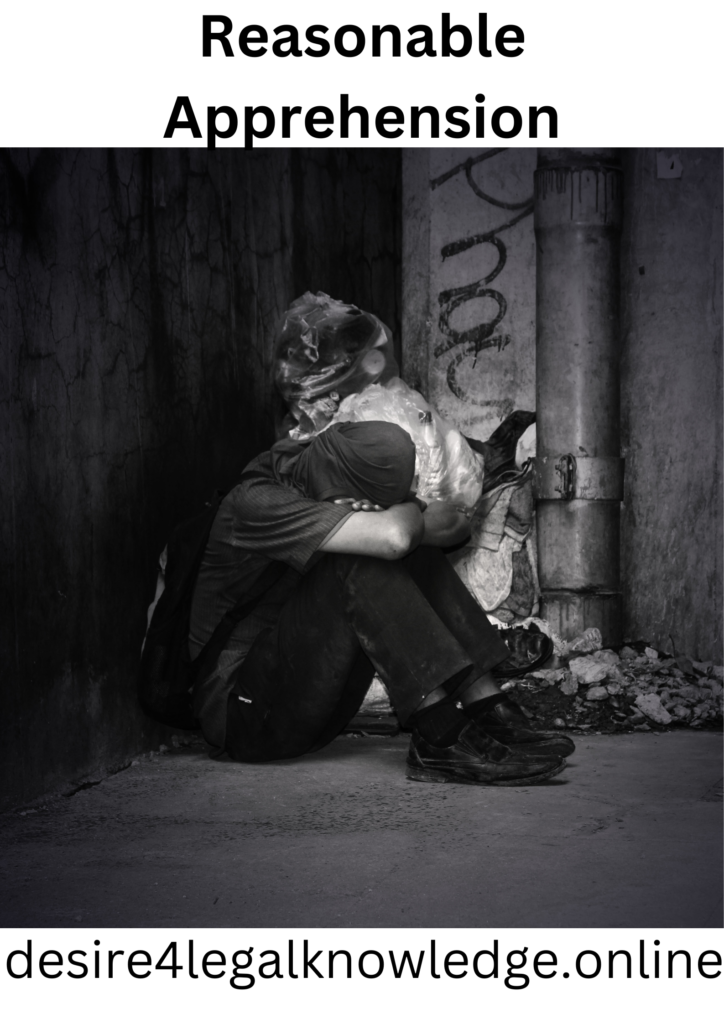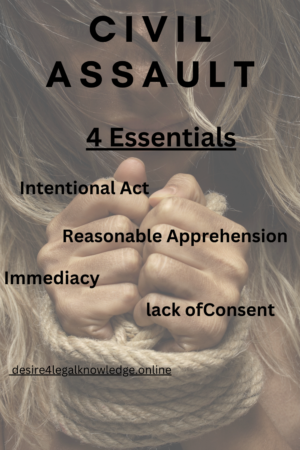Civil Assault and its essentials under Law of Torts
Table of Contents
Introduction
In the realm of tort law, civil assault is a legal concept that addresses the intentional act of causing apprehension or fear of immediate harmful or offensive contact in another person. It is considered a form of personal injury or harm inflicted upon an individual’s mental or emotional well-being rather than their physical state. Civil assault is a crucial aspect of tort law as it seeks to protect individuals from unwarranted threats and provide them with legal recourse in case of such incidents.
Civil Assault
Civil assault, under tort law, refers to the intentional act of causing apprehension or fear of immediate harmful or offensive contact in another person. It is a civil wrong or injury that focuses on the mental or emotional distress inflicted upon an individual, rather than physical harm. Civil assault is a recognized legal claim that allows victims to seek compensation for the harm caused by the intentional infliction of fear or apprehension. It is distinct from criminal assault, which involves the commission of a crime and may result in criminal charges. In civil assault cases, the primary goal is to provide redress to the victim through financial compensation for the emotional distress suffered.


Essentials of Civil Assault
Intentional Act


Assault requires the intentional act of the defendant. The defendant must engage in conduct that is intended to cause apprehension or fear of immediate harmful or offensive contact in the mind of the plaintiff. It is essential that the defendant’s actions are deliberate and not accidental.
Reasonable Apprehensions


The plaintiff must experience reasonable apprehension or fear of immediate harmful or offensive contact. This means that a reasonable person in the plaintiff’s position would also perceive the defendant’s actions as threatening or potentially harmful.
Immediacy


The apprehension or fear felt by the plaintiff must be of immediate harm or offensive contact. It means that the plaintiff believes that the harmful or offensive contact is imminent and will happen without delay. Future threats or distant possibilities do not qualify as assault.
Lack of Consent
In civil assault, lack of consent is an essential element that must be established to prove the occurrence of the assault. Lack of consent refers to the absence of voluntary agreement or permission from the victim for the harmful or offensive physical contact. It means that the victim did not willingly and knowingly give consent to the actions of the defendant that resulted in the assault. Without the victim’s consent, the defendant’s actions are deemed to be unlawful and can be considered as an assault in the civil context.
Difference between Assault and Battery
| Assault | Battery |
| Assault refers to the intentional act of causing apprehension or fear of immediate harmful or offensive contact in another person. | Battery, on the other hand, involves the intentional and unlawful physical contact with another person, which results in harmful or offensive consequences. |
| It focuses on the mental or emotional distress caused by the fear of imminent harm or offensive contact, rather than the physical act itself. | Unlike assault, battery requires actual physical contact to take place. It encompasses any intentional and non-consensual touching of another person. |
| Assault does not require actual physical contact to occur. The emphasis is on the plaintiff’s reasonable belief that they are in imminent danger of harm. | Battery focuses on the physical harm caused by the defendant’s actions, rather than the fear or apprehension experienced by the plaintiff. |
| The key elements of assault are the defendant’s intentional act, the plaintiff’s reasonable apprehension of immediate harm, and the absence of consent. | The key elements of battery are the intentional physical contact, lack of consent, and the resulting harm or offensive consequences suffered by the plaintiff. |
To summarize, assault primarily deals with the intentional act of causing fear or apprehension of immediate harm, while battery involves the intentional and unlawful physical contact resulting in harm or offensive consequences. Assault centers on the mental or emotional distress caused by the fear of harm, while battery focuses on the actual physical harm caused by the contact.
Legal Consequences of Assault
Assault is a serious offense with potential legal consequences. It is essential to be aware of the possible outcomes when dealing with assault cases. The severity of the penalties may vary based on jurisdiction and the specific circumstances of each case. Potential legal consequences of assault include:
1. Criminal Charges
Assault can lead to criminal charges, resulting in a criminal record. Depending on the jurisdiction and the seriousness of the assault, the charges may range from misdemeanor to felony, with corresponding penalties that may include fines and imprisonment.
2. Civil Liability
Apart from criminal charges, the victim of assault can pursue civil action against the perpetrator. In a civil lawsuit, the victim seeks compensation for damages suffered as a result of the assault, such as medical expenses, emotional distress, and loss of income.
3. Restraining Orders
In cases where the victim fears future harm, they may seek a restraining order or protection order against the assailant. Such orders prohibit the perpetrator from contacting or coming near the victim, providing a legal framework to ensure the victim’s safety.
Available Remedies
Victims of civil assault have several remedies available to seek compensation and justice for the harm they have suffered. Here are some common remedies:
Compensatory Damages
The primary remedy in civil assault cases is compensatory damages. This includes economic damages, such as medical expenses, lost wages, and property damage, as well as non-economic damages, including pain and suffering, emotional distress, and loss of enjoyment of life. The aim is to compensate the victim for the physical, emotional, and financial harm caused by the assault.
Punitive Damages
In certain cases where the defendant’s conduct is deemed particularly egregious or malicious, punitive damages may be awarded. These damages go beyond compensating the victim and aim to punish the defendant and deter similar misconduct in the future.
Injunctions and Restraining Orders
In some instances, a victim of civil assault may seek an injunction or restraining order against the perpetrator. This legal remedy can help protect the victim from further harm by prohibiting the assailant from contacting or approaching them.
Criminal Prosecution
While civil assault is a separate legal matter from criminal assault, victims can also pursue criminal charges against the assailant. Criminal prosecution, if successful, can result in the perpetrator facing penalties such as fines, probation, or imprisonment.
Counseling and Therapy
In addition to monetary compensation, victims of civil assault may benefit from therapy or counseling services. These services can help address the emotional and psychological effects of the assault, providing support and aiding in the victim’s recovery.
It is important for victims of civil assault to consult with a knowledgeable attorney who specializes in personal injury law. An attorney can guide them through the legal process, assess the case’s strengths and weaknesses, and help pursue the appropriate remedies for their specific situation.
Legal Process and Time Limits
he legal process and time limits for civil assault cases may vary depending on the jurisdiction. Here is a general overview:
Consultation with an Attorney
The first step for a victim of civil assault is to consult with a personal injury attorney who specializes in assault cases. The attorney will assess the case, discuss legal options, and guide the victim through the process.
Gathering Evidence
The attorney will work with the victim to gather evidence to support the civil assault claim. This may include witness statements, medical records, photographs, video footage, or any other evidence that can establish the defendant’s liability.
Filing a Lawsuit
If the victim decides to proceed with the case, the attorney will file a lawsuit against the alleged assailant. The lawsuit outlines the claims, the damages sought, and the legal basis for the case.
Discovery and Negotiation
During the discovery phase, both parties exchange information, evidence, and may take depositions. Negotiations may also take place to explore the possibility of a settlement agreement without going to trial.
Trial or Settlement
If a settlement cannot be reached, the case may proceed to trial. The victim’s attorney presents the case, including evidence and witness testimony, to the court. The judge or jury will then make a decision on liability and damages.
Regarding time limits, victims must be aware of the statute of limitations for filing a civil assault claim, which varies by jurisdiction. The statute of limitations sets a time limit within which a lawsuit must be filed. It is important to consult with an attorney promptly to ensure compliance with the applicable statute of limitations.
Keep in mind that the legal process can be complex, and each case is unique. It is advisable for victims of civil assault to seek legal advice from an experienced attorney who can provide guidance specific to their jurisdiction and circumstances.


Defenses Against Assault Allegations
Like any legal matter, assault charges can be contested with appropriate defenses. While the availability of defenses may vary depending on the jurisdiction, some common defenses include:
1. Self-Defense
Self-defense is a recognized defense when an individual uses reasonable force to protect themselves from harm. To establish self-defense, the defendant must prove that they reasonably believed they were in imminent danger and that their actions were necessary to prevent harm.
2. Consent
Consent is a potential defense against assault charges if the victim voluntarily agreed to the contact or action that caused apprehension. However, it is important to note that consent must be given freely and without any coercion or fraud.
Conclusion
In conclusion, civil assault is a significant aspect of tort law that addresses the intentional act of causing apprehension or fear of immediate harmful or offensive contact in another person. It is a distinct legal claim that focuses on the mental or emotional distress inflicted upon individuals, rather than physical harm. Understanding the essentials of civil assault, such as the intentional act, reasonable apprehension, immediacy, and lack of consent, provides a framework for victims to seek legal remedies and hold responsible parties accountable for their actions.
Civil assault serves to protect individuals from unwarranted threats and provides them with a means to seek compensation for the emotional distress suffered. By recognizing and addressing civil assault, the legal system aims to promote a society where individuals are safeguarded from intentional acts that cause fear and apprehension.
FAQs
What are the essentials of Assault under Law of Torts?
Following are the 4 essentials of Assault under Law of Torts
1) Intentional Act by the Defendant
2) Reasonable Apprehensions
3) Immediacy
4) Lack of Consent
What is the difference between Civil Assault and Criminal Assault?
The main difference between civil assault and criminal assault lies in the nature of the legal proceedings and the consequences for the defendant. Civil assault is a legal claim under tort law, where the focus is on seeking monetary compensation for the victim’s emotional distress. It is a civil wrong and does not result in criminal charges. In contrast, criminal assault involves the commission of a crime and is prosecuted by the state. It can lead to criminal charges, penalties, and potential imprisonment for the defendant.

